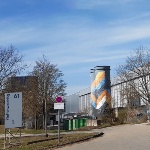- Abstract
-
Many river reservoirs still store large quantities of hazardous contaminants accumulated within the sediments. Due to the significantly reduced sewage discharge into riverine systems over the last decades, relatively unpolluted sediment surface layers cover the old contaminated horizons at river sites of small flow velocities. Nevertheless, increasing bottom shear stress along with enhanced water discharges or flood events might lead to the re-mobilisation of the underlying contaminated sediment layers as was shown in August 2002 during the Elbe flood in Germany. Consequently, the ecological risk of polluted sediment resuspension is important for river management. In the past, investigations on the sediment stability concentrated mostly on hydraulic sediment parameter although the biological influence has been proven to be significant in recent years. Hence, a comprehensive assessment of the stability of contaminated aquatic sediments has to consider the interdependence of all physical, chemical and biological parameters. Consequently, our interdisciplinary research within the unified project SEDYMO (Sediment Dynamic and Mobility, BMBF Germany) covers both hydraulic and biological parameters in order to (A) evaluate the erosion risk of polluted river sites and determine the important parameters as well as (B) recommend master-variables for an efficient and reasonable testing of sediment stability. Because the sediment stability parameter show high vertical, spatial and temporal variability, the sampling strategy is to investigate erosion stability and its characterising parameter over depth at different study sites and at different seasons. The focus was in the year 2003 on monthly campaigns at Lauffen reservoir, River Neckar, Germany (please see Gerbersdorf et al., 2005, Limnologica). In 2004, the reservoirs Deizisau, Hofen and Poppenweiler / River Neckar were investigated at different seasons (please see soon Gerbersdorf et al., submitted to AEHMS). In 2005, groyne fields at the River Elbe were sampled in April (Prelouc, CZ), August and November (fahlberg / List / Magdeburg, Germany). Englischer Titel des Gesamtprojektes: Sediment Dynamics and Pollutant Mobility in River Basins - SEDYMO
- Project manager
-
Bernhard Westrich
-
- Research assistants
-
Sabine Ulrike Gerbersdorf
Thomas Jancke - Department
- Duration
-
From: 2002.07.01
To: 2006.07.31
- Finances
-
Federal Ministry of Education and Research (BMBF)
-


